Podcast
Questions and Answers
What is the primary feature of the dance Singkil?
What is the primary feature of the dance Singkil?
- It showcases balancing oil lamps.
- It involves the use of a fan and bamboo poles. (correct)
- It uses handkerchiefs.
- It is performed on top of a narrow bench.
Which dance is specifically a courtship dance popular in the Eastern Visayas?
Which dance is specifically a courtship dance popular in the Eastern Visayas?
- Kuratsa (correct)
- Dugso
- Pantomina
- Sayaw sa Bangko
Which of the following dances involves balancing glasses on the head and hands?
Which of the following dances involves balancing glasses on the head and hands?
- Binasuan (correct)
- Malong-Malong
- Pangdanggo sa Ilaw
- Alcamfor
What type of movements does the Tausug dance Pangalay emphasize?
What type of movements does the Tausug dance Pangalay emphasize?
Which dance is a celebratory dance performed during harvest by the Manobo tribe?
Which dance is a celebratory dance performed during harvest by the Manobo tribe?
What characterizes the dance Banga?
What characterizes the dance Banga?
Which dance is known as the 'Dance of the Doves'?
Which dance is known as the 'Dance of the Doves'?
What is the primary movement theme of Sinulog?
What is the primary movement theme of Sinulog?
Which traditional dance involves handkerchiefs as a key element?
Which traditional dance involves handkerchiefs as a key element?
What aspect does the dance Tinikling emphasize?
What aspect does the dance Tinikling emphasize?
Which dance represents a mock fight over coconut meat?
Which dance represents a mock fight over coconut meat?
Which dance is performed with clay pots balanced on the head and originates from the Mountain Province?
Which dance is performed with clay pots balanced on the head and originates from the Mountain Province?
What type of movements does the dance Idudu represent?
What type of movements does the dance Idudu represent?
Flashcards are hidden until you start studying
Study Notes
Traditional Filipino Dances
- Pandanggo sa Ilaw: A dance originating from Leyte and Mindoro, featuring candle or oil lamp balancing on the head and hands. Celebrates the Filipino spirit and love for festivals.
- Nilambay: A Bicolano dance that imitates crab movements, showcasing local wildlife and culture.
- Pantomina: Known as the "Dance of the Doves," originating from the Visayas; mimics the courtship of doves.
- Carinosa: A traditional courtship dance from the Tagalog region, highlighted by handkerchief usage and graceful movements.
- La Jota Moncadeña: A lively dance from Ilocos influenced by Spanish tradition, often performed with castanets.
- Tinikling: A folk dance involving quick footwork between two bamboo poles, imitating the movements of birds and symbolizing agility.
- Sinulog: A vibrant dance from Cebu involving lively steps and colorful costumes, performed during the festival of Santo Niño.
- Binaylan: Mimics bird movements and is performed during festivals, particularly focusing on the bond between mother and child.
- Singkil: A royal Muslim dance performed with fans and bamboo poles, representing the epic story of Darangen.
- Bagobo Rice Cycle: Symbolizes the agricultural practices of planting and harvesting rice, reflecting cultural significance in the Northern Philippines.
- Banga: Originates from the Mountain Province; features clay pot balancing on the head, showcasing Filipino women's grace.
- Idudu: A traditional Cordilleran war dance performed by male warriors, highlighting bravery and cultural significance.
- Kuratsa: A dance from the Waray-Waray people depicting daily life activities and courtship, showcasing regional heritage.
- Idaw: Associated with celebrating good harvests in the Cordillera region, emphasizing gratitude and connection with the land.
- Maglalatik: Represents a mock fight over coconut meat, illustrating traditional practices surrounding coconut harvests.
- Itik-Itik: Inspired by duck movements, this dance adds whimsy to festival celebrations.
- Sayaw sa Bangko: A unique performance on top of a narrow bench, testing balance and skill.
- Binasuan: Involves balancing glasses filled with liquid on the head and hands while performing.
- Sakuting: A lively dance where participants strike bamboo sticks together, depicting local festivities.
- Alcamfor: An Ilocano dance utilizing handkerchiefs in its routine, reflecting cultural traditions.
- Dugso: A celebratory dance of the Manobo tribe during harvest seasons, symbolizing thanksgiving.
- Kapa Malong-Malong: Showcases the versatile use of the malong garment, highlighting traditional clothing.
- Kandingan: A Tausog wedding dance, featuring figures inspired by classical and traditional Indian dance forms.
- Pagdiwata: A ritual dance performed by the Tagbanua tribe in Palawan to honor and celebrate spirits.
- Surtido Cebuano: Represents a mix of various regional dances within Cebu, reflecting cultural diversity.
- Sayaw sa Salakot: Performed with dancers donning wide-brimmed hats, showcasing traditional Filipino attire.
- Malong-Malong: Emphasizes the colorful use of fans, illustrating artistic expression in Filipino dance.
Studying That Suits You
Use AI to generate personalized quizzes and flashcards to suit your learning preferences.




